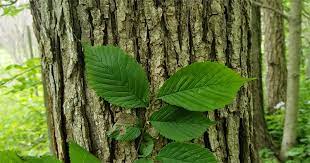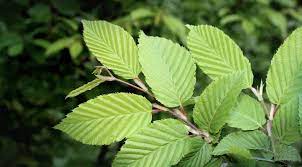SLIPPERY ELM
- Dave

- Mar 30, 2023
- 4 min read
Updated: Apr 8
Slippery Elm

Botanical Name
Ulmus rubra (syn. Ulmus fulva)
Common Name
Slippery elm, red elm, soft elm, moose elm
Family
Ulmaceae
Parts Used
Inner bark
Native To
Slippery elm is native to Southern Ontario as well as the Central and Eastern United States (Kane, 2009; Missouri Botanical Garden, n.d.).
Harvesting Guidelines
When harvesting slippery elm (Ulmus rubra), it is essential to follow sustainable practices to protect the species, which is facing pressure from overharvesting. Due to concerns over the scarcity of slippery elm, it is crucial to refrain from harvesting bark from living trees. Instead, gather bark from naturally fallen branches or trees that have died, ensuring that the tree remains undisturbed and continues to contribute to the ecosystem. This practice helps to preserve the population of slippery elm in the wild and ensures that future generations will continue to benefit from its medicinal properties.
Slippery elm has been a valued medicinal plant for centuries, particularly by various Native American tribes. Its use spans a wide array of health conditions, from digestive issues to respiratory concerns, and it remains a popular remedy in both traditional and modern herbal practices. Native American tribes such as the Cherokee, Alabama, and Catawba have used slippery elm for diverse medicinal purposes. For instance, the Cherokee used it to aid in childbirth and to treat dysentery, while the Catawba utilized it to treat consumption (tuberculosis). Known for its soothing properties, slippery elm is an effective remedy for inflammation, diarrhea, and a variety of other ailments.
Traditional Uses in Indigenous Medicine
The versatility of slippery elm made it an essential herb in Native American medicine. The mucilaginous quality of its bark, which forms a thick, slippery gel when mixed with water, is a key factor in its use. The Cherokee, for example, utilized the inner bark of slippery elm as a poultice for wounds and infections, leveraging its demulcent properties to reduce inflammation and promote healing.
In addition to its use as a poultice for topical ailments, slippery elm was also consumed internally to address digestive complaints. Its soothing effects on the mucous membranes made it especially useful for conditions like sore throat, ulcers, and gastrointestinal issues, including diarrhea. The Catawba tribe famously used slippery elm to treat consumption, recognizing its ability to heal and nurture the body.
Historical Use in Western Herbalism
In European herbal traditions, slippery elm has been valued for its ability to soothe irritated tissues. The herb was commonly used for respiratory conditions, such as coughs and sore throats, and for gastrointestinal issues, such as ulcers and colitis. Herbalist Nicholas Culpeper, writing in the 17th century, recommended slippery elm as an excellent remedy for inflamed lungs and sore throats due to its moistening, soothing qualities.
Its demulcent properties made slippery elm a mainstay for treating dry, irritated mucous membranes, especially in the upper respiratory and digestive systems. The herb was often combined with other soothing herbs to enhance its healing effect, particularly in cases of chronic irritation.
Modern Use and Applications
In modern herbalism, slippery elm is still widely used for its calming and healing properties, especially for conditions involving mucous membranes. Its mucilage is particularly useful for soothing inflamed tissues in the digestive tract, making it a popular remedy for conditions such as irritable bowel syndrome (IBS), colitis, and heartburn.
Slippery elm is also used to treat sore throats, coughs, and other respiratory issues. Its ability to form a protective gel-like coating on the throat can help alleviate discomfort caused by throat infections or irritation from coughing. It has also gained popularity for its ability to reduce inflammation in the digestive tract and promote overall gut health.
In Ayurvedic medicine, slippery elm is used to soothe irritated mucous membranes and ulcerated tissues. It is often recommended for conditions like ulcerative colitis, burns, and skin eruptions, owing to its emollient and vulnerary properties.
Scientific Research and Health Benefits
Recent scientific studies have supported many of the traditional uses of slippery elm, particularly its effects on inflammation and irritation. The mucilage in slippery elm has been shown to have a soothing and protective effect on inflamed tissues, which is why it is often used for digestive and respiratory conditions.
Digestive Health: Research confirms slippery elm's beneficial effects on the digestive system, particularly its ability to treat conditions like heartburn, IBS, and colitis. The mucilage helps to coat and soothe the lining of the stomach and intestines, reducing irritation caused by acid reflux and inflammation.
Respiratory Health: The demulcent properties of slippery elm make it effective for soothing sore throats and coughs. The mucilage provides a protective layer on the throat, which helps to reduce irritation and promote healing.
Anti-inflammatory Effects: The soothing and anti-inflammatory effects of slippery elm have been supported by scientific research, which shows that it can reduce inflammation in the digestive and respiratory systems. The herb's high content of antioxidants also contributes to its ability to protect tissues from damage caused by free radicals.
Safety Considerations and Dosage
Slippery elm is generally considered safe when used appropriately, but as with any herb, it's important to be mindful of individual reactions and potential interactions with medications. As slippery elm is moistening and cooling in nature, individuals with conditions like lung congestion, phlegm, or edema may need to avoid it. Additionally, those with a "high kapha" constitution in Ayurveda are cautioned against using slippery elm excessively, as it could exacerbate these conditions.
For those new to slippery elm, starting with smaller doses and gradually increasing is recommended to assess tolerance. Slippery elm is often consumed as a powder, gruel, or
infusion. Here are typical dosages:
Powder: 500 mg–2 g per day
Capsules: 2–3 "00" capsules 2–3 times per day
Gruel: 2–3 tablespoons of gruel 2–3 times per day
Infusion: 4–8 fl oz of cold infusion (1 oz dried bark in 1 quart water), as needed
Actions
Astringent,Demulcent,Emollient,Expectorant,Vulnerary
Energy
Cooling,Moistening
References:
References
Taylor, L.A. (1940). Plants used as curatives by certain Southeastern tribes. Cambridge, MA: Botanical Museum of Harvard University. Retrieved from http://www.wildonesniagara.org/images/PlantsUsedAsCuratives.pdf
Frawley, D., & Lad, V. (2001). The yoga of herbs. Twin Lakes, WI: Lotus Press.
Tierra, M. (1998). The way of herbs. New York, NY: Pocket Books.
Kane, C.W. (2009). Herbal medicine: Trends and traditions. Tucson, AZ: Lincoln Town Press.
Frawley, D., & Lad, V. (2001). The yoga of herbs. Twin Lakes, WI: Lotus Press.
tags:
Herbal medicine course
herbal school
wildpluk cursus
kruiden opleiding
geneeskrachtige planten
herborist
become a herbalist






